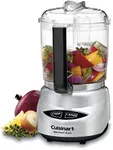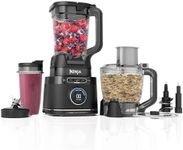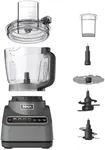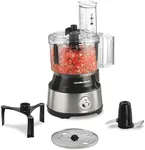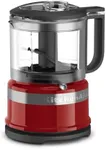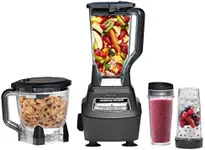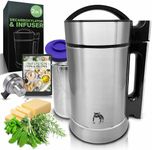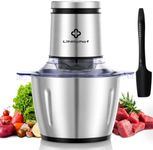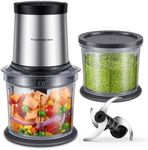Buying Guide for the Best multi food processor
Choosing the right multi-food processor can make a significant difference in your kitchen efficiency and the quality of your meals. A multi-food processor is a versatile appliance that can handle a variety of tasks such as chopping, slicing, grating, and even kneading dough. To find the best fit for your needs, it's important to understand the key specifications and how they align with your cooking habits and preferences.Power (Wattage)Power, measured in watts, determines the efficiency and capability of the food processor. Higher wattage means the processor can handle tougher tasks like kneading dough or chopping hard vegetables more easily. For light tasks like chopping herbs or making sauces, a lower wattage (around 400-600 watts) is sufficient. For more demanding tasks, look for a processor with 700 watts or more. Consider your typical usage to decide the right power level for you.
Bowl CapacityBowl capacity indicates how much food the processor can handle at once. Smaller capacities (around 1-2 liters) are suitable for small families or occasional use. Medium capacities (2-3 liters) are versatile for most households, while larger capacities (3 liters and above) are ideal for big families or frequent entertaining. Think about the quantity of food you usually prepare to choose the right bowl size.
Attachments and AccessoriesAttachments and accessories expand the functionality of your food processor. Common attachments include slicing discs, grating discs, dough blades, and blending jars. More attachments mean more versatility, but also more storage space required. If you enjoy experimenting with different recipes, look for a model with a variety of attachments. If you prefer simplicity, a basic model with essential attachments might be sufficient.
Speed SettingsSpeed settings allow you to control the processing speed for different tasks. Basic models may have just one or two speeds, while advanced models offer multiple speed settings and pulse functions. More speed options provide greater control and precision, which is useful for delicate tasks like whipping cream or more robust tasks like chopping nuts. Consider what types of food you will be processing to determine the necessary speed settings.
Ease of CleaningEase of cleaning is crucial for maintaining your food processor. Look for models with dishwasher-safe parts to save time and effort. Also, consider the design of the processor; fewer crevices and detachable parts make cleaning easier. If you plan to use your processor frequently, prioritize models that are easy to clean to ensure you enjoy using it without the hassle of extensive cleanup.
Build Quality and DurabilityBuild quality and durability are important for the longevity of your food processor. Models with sturdy construction, often indicated by the use of high-quality materials like stainless steel, tend to last longer and perform better. Check user reviews and brand reputation to gauge the durability of a model. If you plan to use your processor regularly, investing in a durable model will be more cost-effective in the long run.
Safety FeaturesSafety features are essential to prevent accidents during use. Look for features like non-slip feet, safety interlocks that prevent the processor from operating if not assembled correctly, and overload protection to prevent motor burnout. These features are particularly important if you have children or if multiple people will be using the appliance. Prioritize models with comprehensive safety features to ensure safe operation.
